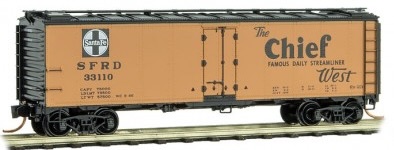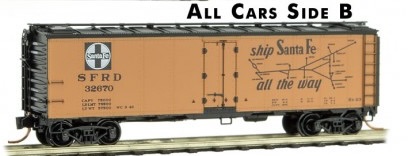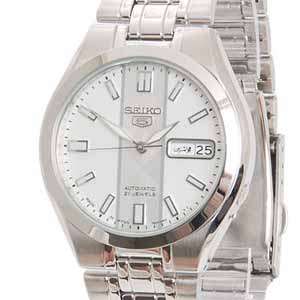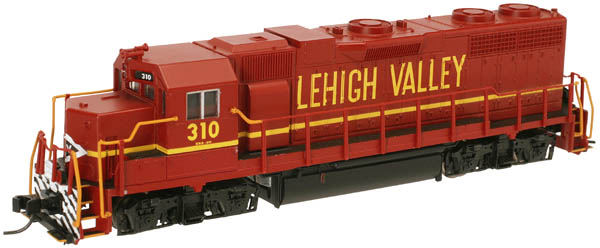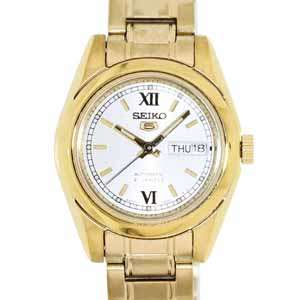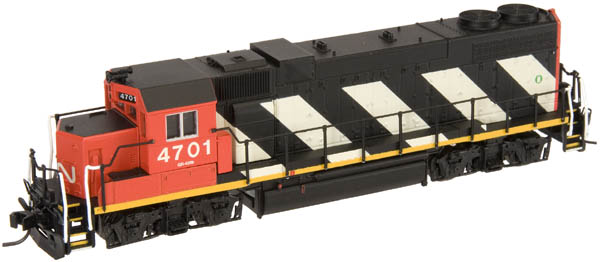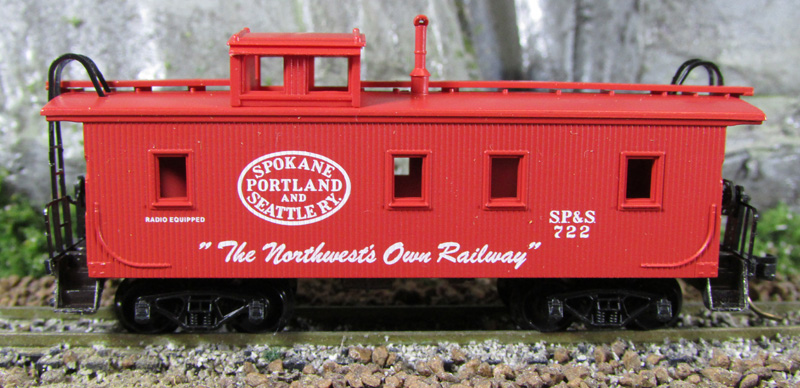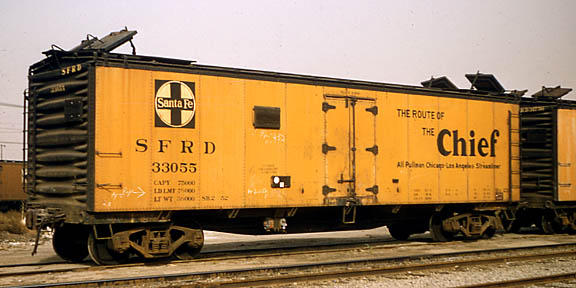Model Information: The prototype for this model is the PFE R-40-10 ice reefer built in 1936 and 1937.
MTL released this model with various road names, for which the actual prototype might in fact be different.
MTL released this model with various road names, for which the actual prototype might in fact be different.
Prototype History: The Santa Fe Refrigerator Despatch (reporting mark SFRD) was a railroad refrigerator car line established as a subsidiary of the Atchison, Topeka and Santa Fe Railway (often shorten in Santa Fe) in 1884 to carry perishable commodities. At its peak in the '50s, the fleet of SFRD reefer was in excess of 14,000 cars, making it the second largest reefer fleet serving the west after PFE (Pacific Fruit Express, a subsidiarity of Union Pacific and Southern Pacific).
The curved-line and straight-line maps began to be used in 1940, depending on which shop did the repaint. Sometime around 1943 the straight-line maps became the norm and were predominate through 1947. The billboard slogans at that time included: Grand Canyon Line, Scout, El Capitan, Super Chief, and Chief.
Cars repainted before 1944 had periods in the S.F.R.D. reporting marks; after that the periods were dropped and the reporting marks were S F R D.
In 1947, the maps were no long painted and Ship and Travel Santa Fe All the Way took its place. The Scout name was dropped in 1947. By 1952, the surviving map/slogan cars would have been pretty dirty and well weathered; cleaner SFRD reefers had the later slogan scheme.
In 1958, the slogans went away and the large billboard Herald became the standard. Cars ran with this scheme until the mid 70s when ice reefers became obsolete.
Rebuilt reefers:
Between 1937 and the early '40s , Santa Fe rebuilt over 4100 of its 40' wood reefers as steel sheathed reefers, all to virtually the same design. These former USRA cars kept their fishbelly center sill underframes. Given that they have been rebuilt in several batches, they are all similar but with small variations on doors and platforms around ice hatches. They are classified as Rr-19, 21, 23, 25, 27, 28, 29 and 32.
- Rr-19 SFRD 31254 - 31655 rebuilt 1937
- Rr-21 SFRD 34000 - 34499 rebuilt 1937
- Rr-23 SFRD 31656 - 33155 rebuilt 1938
- Rr-25 SFRD 33156 - 33455 rebuilt 1939
- Rr-25 SFRD 33556 - 33655 rebuilt 1939
- Rr-27 SFRD 34500 - 34950 rebuilt 1939
- Rr-28 SFRD 35000 - 35499 rebuilt 1940 (platform inboard of the ice hatches)
- Rr-29 SFRD 36000 - 36300 rebuilt 1940
- Rr-32 SFRD 35500 - 35999 rebuilt 1941 (platform inboard of the ice hatches)
More details on this site.
The curved-line and straight-line maps began to be used in 1940, depending on which shop did the repaint. Sometime around 1943 the straight-line maps became the norm and were predominate through 1947. The billboard slogans at that time included: Grand Canyon Line, Scout, El Capitan, Super Chief, and Chief.
Cars repainted before 1944 had periods in the S.F.R.D. reporting marks; after that the periods were dropped and the reporting marks were S F R D.
In 1947, the maps were no long painted and Ship and Travel Santa Fe All the Way took its place. The Scout name was dropped in 1947. By 1952, the surviving map/slogan cars would have been pretty dirty and well weathered; cleaner SFRD reefers had the later slogan scheme.
In 1958, the slogans went away and the large billboard Herald became the standard. Cars ran with this scheme until the mid 70s when ice reefers became obsolete.
Rebuilt reefers:
Between 1937 and the early '40s , Santa Fe rebuilt over 4100 of its 40' wood reefers as steel sheathed reefers, all to virtually the same design. These former USRA cars kept their fishbelly center sill underframes. Given that they have been rebuilt in several batches, they are all similar but with small variations on doors and platforms around ice hatches. They are classified as Rr-19, 21, 23, 25, 27, 28, 29 and 32.
- Rr-19 SFRD 31254 - 31655 rebuilt 1937
- Rr-21 SFRD 34000 - 34499 rebuilt 1937
- Rr-23 SFRD 31656 - 33155 rebuilt 1938
- Rr-25 SFRD 33156 - 33455 rebuilt 1939
- Rr-25 SFRD 33556 - 33655 rebuilt 1939
- Rr-27 SFRD 34500 - 34950 rebuilt 1939
- Rr-28 SFRD 35000 - 35499 rebuilt 1940 (platform inboard of the ice hatches)
- Rr-29 SFRD 36000 - 36300 rebuilt 1940
- Rr-32 SFRD 35500 - 35999 rebuilt 1941 (platform inboard of the ice hatches)
More details on this site.
Road Name History: The Atchison, Topeka and Santa Fe Railway (reporting mark ATSF), often abbreviated as Santa Fe or AT&SF, was one of the larger railroads in the United States. Chartered in February 1859, the railroad reached the Kansas-Colorado border in 1873 and Pueblo, Colorado, in 1876. To create a demand for its services, the railroad set up real estate offices and sold farm land from the land grants that it was awarded by Congress. Despite the name, its main line never served Santa Fe, New Mexico, as the terrain was too difficult; the town ultimately was reached by a branch line from Lamy.
The Santa Fe was a pioneer in intermodal freight transport, an enterprise that (at one time or another) included a tugboat fleet and an airline (the short-lived Santa Fe Skyway). Its bus line extended passenger transportation to areas not accessible by rail, and ferryboats on the San Francisco Bay allowed travelers to complete their westward journeys to the Pacific Ocean. The ATSF was the subject of a popular song, Harry Warren & Johnny Mercer's "On the Atchison, Topeka and the Santa Fe", written for the film, The Harvey Girls (1946).
The railroad officially ceased operations on December 31, 1996, when it merged with the Burlington Northern Railroad to form the Burlington Northern & Santa Fe Railway.
Read more on Wikipedia.
The Santa Fe was a pioneer in intermodal freight transport, an enterprise that (at one time or another) included a tugboat fleet and an airline (the short-lived Santa Fe Skyway). Its bus line extended passenger transportation to areas not accessible by rail, and ferryboats on the San Francisco Bay allowed travelers to complete their westward journeys to the Pacific Ocean. The ATSF was the subject of a popular song, Harry Warren & Johnny Mercer's "On the Atchison, Topeka and the Santa Fe", written for the film, The Harvey Girls (1946).
The railroad officially ceased operations on December 31, 1996, when it merged with the Burlington Northern Railroad to form the Burlington Northern & Santa Fe Railway.
Read more on Wikipedia.
Brand/Importer Information: Micro-Trains is the brand name used by both Kadee Quality Products and Micro-Trains Line. For a history of the relationship between the brand and the two companies, please consult our Micro-Trains Collector's Guide.
Manufacturer Information:  Micro-Trains Line split off from Kadee Quality Products in 1990. Kadee Quality Products originally got involved in N-Scale by producing a scaled-down version of their successful HO Magne-Matic knuckle coupler system. This coupler was superior to the ubiquitous 'Rapido' style coupler due to two primary factors: superior realistic appearance and the ability to automatically uncouple when stopped over a magnet embedded in a section of track. The success of these couplers in N-Scale quickly translated to the production of trucks, wheels and in 1972 a release of ready-to-run box cars.
Micro-Trains Line split off from Kadee Quality Products in 1990. Kadee Quality Products originally got involved in N-Scale by producing a scaled-down version of their successful HO Magne-Matic knuckle coupler system. This coupler was superior to the ubiquitous 'Rapido' style coupler due to two primary factors: superior realistic appearance and the ability to automatically uncouple when stopped over a magnet embedded in a section of track. The success of these couplers in N-Scale quickly translated to the production of trucks, wheels and in 1972 a release of ready-to-run box cars.
Micro-Trains Line Co. split off from Kadee in 1990 to form a completely independent company. For this reason, products from this company can appear with labels from both enterprises. Due to the nature of production idiosyncrasies and various random factors, the rolling stock from Micro-Trains can have all sorts of interesting variations in both their packaging as well as the products themselves. When acquiring an MTL product it is very important to understand these important production variations that can greatly enhance (or decrease) the value of your purchase.
Please consult our Micro-Trains Collector's Guide

Micro-Trains Line Co. split off from Kadee in 1990 to form a completely independent company. For this reason, products from this company can appear with labels from both enterprises. Due to the nature of production idiosyncrasies and various random factors, the rolling stock from Micro-Trains can have all sorts of interesting variations in both their packaging as well as the products themselves. When acquiring an MTL product it is very important to understand these important production variations that can greatly enhance (or decrease) the value of your purchase.
Please consult our Micro-Trains Collector's Guide
Item created by: CNW400 on 2022-03-04 12:47:23. Last edited by Alain LM on 2022-06-25 02:50:54
If you see errors or missing data in this entry, please feel free to log in and edit it. Anyone with a Gmail account can log in instantly.
If you see errors or missing data in this entry, please feel free to log in and edit it. Anyone with a Gmail account can log in instantly.


